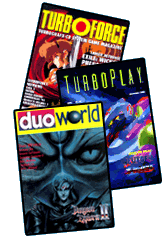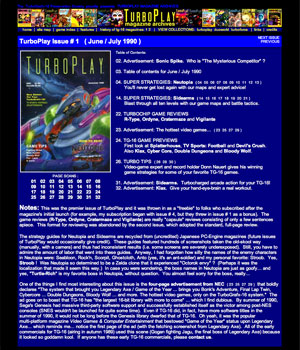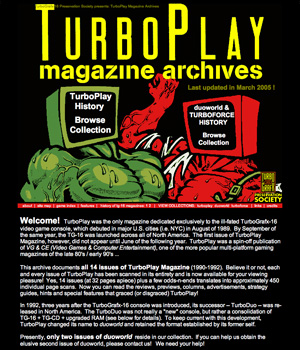One fateful day, a few years ago, I wrote a short article about my memories of TurboPlay Magazine and posted it on a previous incarnation of tg-16.com. Slowly, I began to receive emails asking for additional information about TurboPlay and the other magazines that focused exclusively on the TurboGrafx-16 and TurboDuo consoles. I was surprised to receive these emails. I thought every nook and cranny of the TurboGrafx-16 universe had been thoroughly documented. And yet, as late as 2003, if you were to survey the resources available on the internet, you would not have found more than a few random references to TurboPlay Magazine. At that point, I knew I had to rectify things. This site was born.
Continued below…
A brief history of TG-16 magazines in North America
 Note: If you are new to the world of TurboGrafx-16 / PC-Engine / DUO, then read a brief history of the Duo that appeared in the premier issue of DuoWorld Magazine (July 1993).
Note: If you are new to the world of TurboGrafx-16 / PC-Engine / DUO, then read a brief history of the Duo that appeared in the premier issue of DuoWorld Magazine (July 1993).
In September of 1989, NEC launched the TurboGrafx-16 (TG-16) video game console across North America. Many multi-platform magazines covered TG-16 (e.g. EGM, VG&CE, GamePro, GameFan, Game Player's, Game Informer, Electronic Games, Video Games, etc.), but only a handful of publications were dedicated exlusively to the console: TurboPlay, TurboEdge, DuoWorld and TurboForce.
The first issue of TurboPlay Magazine did not appear until June of 1990. TurboPlay was a spin-off publication of Video Games & Computer Entertainment (VG&CE), one of the more popular multi-platform gaming magazines of the late 1980's / early 1990's. Ultimately, 14 issues of TurboPlay (bi-monthly, 32 pages, June 1990 - August 1992) were published, making it the most successful of the four titles.
In October of 1992, three years after the TurboGrafx-16 console was introduced, its successor—TurboDuo—was released in North America. The TurboDuo (later simply called "Duo") was a "new" console that consolidated existing technology (TurboGrafx-16 + TurboGrafx-CD + upgraded RAM) in a sleek new form. To keep current with this development, TurboPlay would eventually be reborn as DuoWorld Magazine. Only three issues of DuoWorld (bi-monthly, July 1993 - November 1993) were published. The premier issue was superb (32 pages), but the final two issues were only 16 pages in length.
In an effort to promote their new TurboDuo console, Turbo Technologies Inc. (TTi), vis-a-vis Sendai, published TurboForce Magazine (4 quarterly issues, 32 pages, Summer 1992 - Spring 1993). TurboForce was completely under the editorial control of TTi (unlike TurboPlay and DuoWorld, which were published by L.F.P.). Devoid of any critical software reviews, TurboForce unabashedly promoted TurboDuo and its software releases. Not surprisingly, the first issue of TurboForce was included with every TurboDuo console. This debut issue provided strategy guides for TurboDuo's five pack-in games and served as a nice introduction to the TG-16 universe. TurboForce, thankfully, filled the vacuum created by the cancellation, in the Summer of 1992, of TurboPlay Magazine. Turboforce was the only title new Duo owners could turn to during the crucial first 8 months following the North American launch of the Duo. The fourth and last issue of TurboForce was released in the Summer of 1993, coninciding with the introduction of the short-lived DuoWorld Magazine.
▲
R.I.P. The Old Archives (2003-2008)
The screenshots below (click images for full-size) were taken in March of 2005, the month I stopped updating the old site and it became moribund. I still love the big, goofy homepage anchored by the muscle-bound he-men. Bigger is better!


Now that I look at the old site, I'm not sure that the new layout I designed is much of an improvement. The old site was barbaric, certainly, but it was simple and easy to use. The new site, in contrast, is cluttered with crap. Plus, I like how the old format provided large images for each magazine's cover, instead of the tiny thumbnails used now. Oh well. Time marches on…
The current website, believe it or not, was nearly completed in the summer of 2005, yet it would not go live for nearly three years. If you are so inclined, you can read about why it took so long.
▲
Return to top of page…